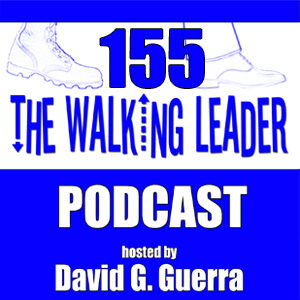MBWA (Management By Walking Around) “refers to a style of business management which involves managers wandering around, in an unstructured manner, through the workplace(s), at random, to check with employees, equipment, or on the status of ongoing work. The emphasis is on the word wandering as an unplanned movement within a workplace, rather than a plan where employees expect a visit from managers at more systematic, pre-approved or scheduled times.
The expected benefit is that a manager, by random sampling of events or employee discussions, is more likely to facilitate improvements to the morale, sense of organizational purpose, productivity and total quality management of the organization, as compared to remaining in a specific office area and waiting for employees, or the delivery of status reports, to arrive there, as events warrant in the workplace.”1
The Walking Leader as it applies to MBWA.
While the premise of MBWA is to go in an “unstructured manner…at random” sounds great and the spontaneity of the getting out seems the best way to catch them off guard. It is also the best way to NOT get it done, to not make it happen. When you are out of being spontaneous what have you got? You have the uncertainty of not being able to keep them on the edge or on their toes, patiently or impatiently waiting for your arrival. Eventually, that uncertainty will lead to doubt. Once doubt creeps in, the want and will to do the MBWA becomes difficult and will lead to stopping all together.
The Walking Leader calls for the intentional manner of scheduling time, planning a route and leave the spontaneity to the conversations you will encounter. By planning and scheduling time ensures that you have the time set aside to get out there and walk around. Those you are walking around to see and meet will expect you and they too can alter their schedules, as well.
Now you may ask what about the randomness. Of course, you can always mix things up. Intentionally, mix things up. The Walking Leader encourages randomness but to keep things focused on allowing those you are walking around to see and meet to continue doing their job. Never let the spontaneity and randomness of MBWA become a distraction to the workflow. Then again, never let the schedule and planning become a distraction to their workflow as well as yours.
However, as the Walking Leader you should make MBWA part of your workflow. By making the time, effort, and interaction a part of your day’s workflow you are giving yourself the ability to obtain more information, achieve higher visibility, and of course, your ability to walk your talk leads to and lends to increased credibility.
Integrating the 20 rules of the Walking Leader allows anyone to go out and about the organization loaded with the tools which can be altered to fit any leader, leader’s mission and vision, as well as any organization’s mission and vision. The twenty rules of the Walking Leader are designed to empower any leader by making them the right fit for each unique situation found in about any modern workplace, no matter the industry.
Simply, being the Walking Leader is leading by example. Management By Walking Around is the method that allows the Walking Leader to lead by example. Leading by Example is how new leaders are made. Making new leaders is the primary mission and focus of ALL Leaders.
1 https://en.wikipedia.org/wiki/Management_by_wandering_around
 There comes a time when ALL leaders will face certain challenges. Not the everyday kind of challenges but those challenges that in the end will set you apart from the rest of the crowd; the pack. Those challenges are those that require you (as a leader) to step up and take the reins of the situation. People that follow you or will eventually follow you will see that you have the GRIT (courage and resolve; strength of character) to a leader worthy of their followership.
There comes a time when ALL leaders will face certain challenges. Not the everyday kind of challenges but those challenges that in the end will set you apart from the rest of the crowd; the pack. Those challenges are those that require you (as a leader) to step up and take the reins of the situation. People that follow you or will eventually follow you will see that you have the GRIT (courage and resolve; strength of character) to a leader worthy of their followership.